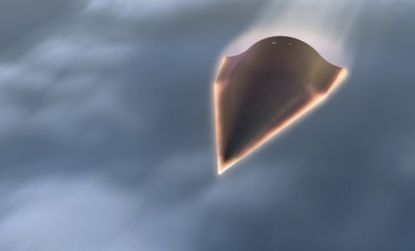The Pentagon's 'blistering' fast new plane: Crash and burn?
Why do the military's experimental supersonic airplanes keep disappearing?

An experimental airplane capable of flying unmanned at 20 times the speed of sound was launched today from Vandenberg Air Force Base in California — and promptly disappeared. The "blistering" fast military aircraft, dubbed the Falcon Hypersonic Test Vehicle 2 (HTV-2), is designed to cover a distance equal to that between New York and Los Angeles in less than 12 minutes. At such a speed, "air doesn't travel around you — you rip it apart," the military boasted on its website. But shortly after the HTV-2's flight began, engineers lost all contact with the craft. Here, a brief guide:
What happened on its flight? The HTV-2 was sent into the upper reaches of the atmosphere on the back of a Minotaur IV rocket. It then successfully disengaged from the rocket and began to nose-dive toward the Pacific Ocean, where it was supposed to level off and reach speeds of about 13,000 miles per hour for about 30 minutes. But all contact with the HTV-2 was lost just a few minutes into the flight — and an "eerily similar" problem occurred during a 2010 test flight of the first HTV-2.
What occurred on that first flight? In April 2010, after just nine minutes of flight time, the first HTV-2 craft was also lost. Both planes were equipped with what the military calls "autonomous flight termination capability," which means the wedge-shaped airplanes are designed to automatically crash into the ocean at the end of their test flights.
Subscribe to The Week
Escape your echo chamber. Get the facts behind the news, plus analysis from multiple perspectives.

Sign up for The Week's Free Newsletters
From our morning news briefing to a weekly Good News Newsletter, get the best of The Week delivered directly to your inbox.
From our morning news briefing to a weekly Good News Newsletter, get the best of The Week delivered directly to your inbox.
Were these flights a total loss? Not exactly, according to the military. Even though the first HTV-2 flight ended after only nine minutes, "the flight yielded valuable data, including 139 seconds of data on extremely high-speed flight, ranging from Mach 17 to Mach 22," or 17 to 22 times the speed of sound.
Sources: LA Times, NY Daily News, Space.com, USA Today, Wall Street Journal
Sign up for Today's Best Articles in your inbox
A free daily email with the biggest news stories of the day – and the best features from TheWeek.com
Create an account with the same email registered to your subscription to unlock access.
-
 What is cloud seeding and did it cause Dubai's severe rainfall?
What is cloud seeding and did it cause Dubai's severe rainfall?The Explainer The future is flooded
By Devika Rao, The Week US Published
-
 American Airlines pilots are warning of a 'significant spike' in safety issues
American Airlines pilots are warning of a 'significant spike' in safety issuesIn the Spotlight The pilot's union listed 'problematic trends' they say are affecting the airline's fleet
By Justin Klawans, The Week US Published
-
 6 star-spangled presidential libraries to visit
6 star-spangled presidential libraries to visitThe Week Recommends These institutions provide insight into American leaders
By Catherine Garcia, The Week US Published